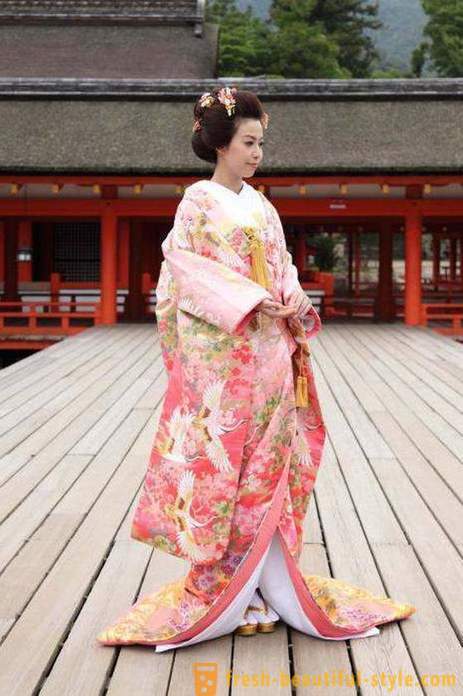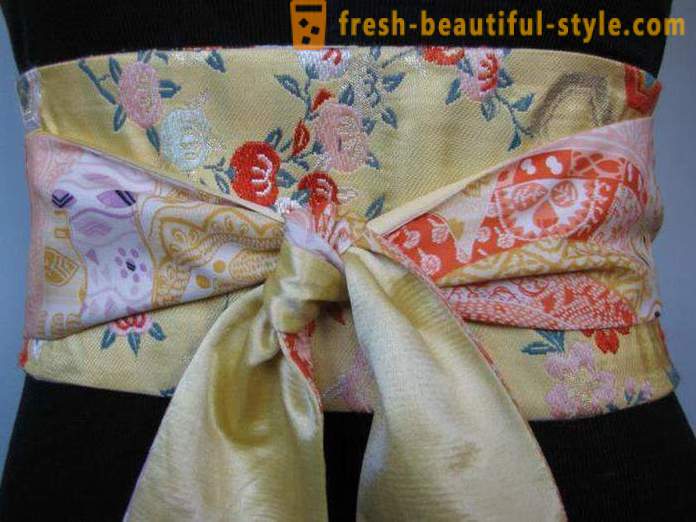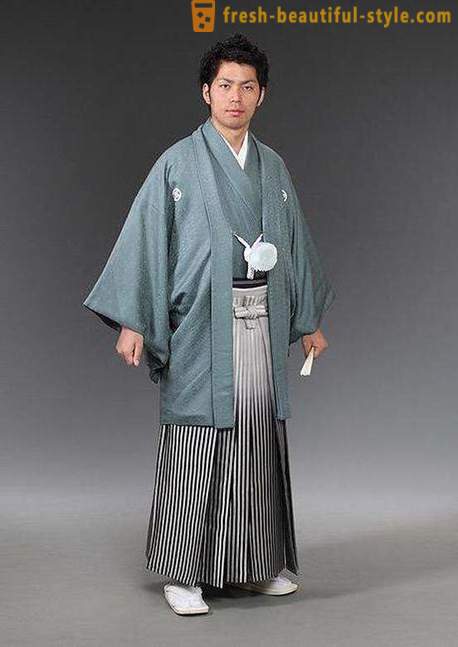Kimono Japanese history origin, characteristics and traditions
In Japanese, the word "kimono" means "clothing". And initially they called all types of vestments. But over time, the term was fixed solely for "robe", which are worn by many Asians of all ages to the present day.
The shape of the traditional Japanese kimono very long (up to the ankles), and it looks like the letter T. But it is absolutely all the seams are straight. Also available collar. The width of the arms are always different lengths and can tell a lot about the owner of a kimono. For example, girls of marriageable age kimono with long and wide sleeves. Moreover, the length may reach to the floor and a width of up to half a meter.

How to tie and wear?
Kimono Japanese plowed so that the left end is on top right. In other words - on the right side. Similarly, dress up as women and men. And on the left side of his plowed solely on the deceased.
Soft and wide belt called Japanese kimono obi. It several times wrapped around the body and tied at the back of complex bow. If the unit is at the front, so, wearing a kimono girl, she is a representative of the oldest profession - dzoro. It should be noted that the Japanese clothing suitable not all shoes (about modern at all costs to forget), and only traditional. It's called zori or geta. And usually wear kimono in "plural". That is, under the top, which is the most richly decorated, put on some low, looking worse. They are called "nagadzhuban". Now that you know how to tie a Japanese kimono and wear it. Come on.

The History of
Japanese kimono was a copied the Chinese national costume Hanfu in the V century. n. e. Just at that time between the Asian countries are actively developing cultural ties. Well, the final form of the kimono has become in the era Heian, which lasted from 794 in 1192. Since the appearance of traditional Japanese clothing has remained unchanged. All women's kimono doing the same size. But already then the owner themselves customize clothes for her figure, tucking it as it suits them. Japanese costume sewn from a single piece of fabric, which in the old days to do by hand. It also embroidered by hand, so cost a lot of money and was worn very carefully. Now in Japan for sewing traditional costume makes special fabric certain width and length. It need only be cut into squares and stitch.
Washing
In ancient times to wash the Japanese kimono, it ripped, and then sewn together again. By contrast, modern methods of cleaning fabrics negated this need. Although in some places the traditional Japanese costume continue to erase the old fashioned way. To avoid excessive bruising, wrinkles and tangling layers of Japanese clothing, it smotyvayut free and large stitches.

Women's and men
For centuries, it appeared a lot of different options for colors, fabrics and shapes of traditional Japanese costume. There are also a variety of kimono styles - from the frankly frivolous to the most officious. The degree of formality of traditional women's clothes in the first place determined by the model, fabric and color. Sleeve kimono for women is much longer for older Japanese. In addition, youth traditional clothing is much more complicated in terms of pointing.
Japanese kimono (male) has only one shape and sewn fabrics from solely muted colors. A clothes formality determined by the color and type of accessories, fabrics views, as well as the amount (or lack) of family coats of arms. The most desired fabric for the Japanese costume is silk. It is most officialdom. Second place confidently takes cotton. A third polyester kimono of which are quite rare. Now, both male and female traditional costume can buy the required size. Since the Japanese kimono sew from a roll of fabric, it is very difficult to find clothes large size. Well, quite expensive tailoring will cost a great costume. It is known that all sumo clothes sewn to order.

Price
The cost of traditional Japanese costume can easily will exceed 10 thousand dollars. Well, the price of the full kit (ties, tabi, sandals, obi and underwear) sometimes reaches up to 20 thousand dollars. Even a belt, made in a single copy can cost as much as the whole kimono.
However, many Japanese costumes belonging to a historical re-enactors and collectors are cheaper. Activists make their own clothes: the old alter or use a standard as an example. Well-colored silk cloth is replaced by woven machine. In the domestic market is a shabby kimono costs about 500 yen, and made the pattern for women obi - 1500 yen. Men's belt is short and narrow, so their price is much lower.
Operation
Kimono in Japan have never wasted. Old clothes used to make a variety of things:
- Children's kimono.
- haori.
- The large pieces of fabric makes handbags and other accessories.
- Also, the fabric used for repairing the same kimono.
If a traditional Japanese costume damaged by the waist, it can be worn with hakama - baggy trousers, like a skirt. There were also craftsmen manage to dissolve the spoiled kimono on a thread and twisting them into new tissue, equal to the width of the male obi. Such a method of improvement clothing called saki-ori.

Modern period
Now kimono are usually worn only in formal occasions and usually only girls. Older women (and some men) wear traditional Japanese clothes on a daily basis. Kimono dress professionally sumoists every day. In public, outside the ring, they are obliged to wear it. And more kimonos worn to tea ceremonies, weddings, various sporting events (Kendo, etc..), New Year, dead wires, national holidays, the end of high school or high school, and so on. D. By the way, for a foreign tourist with a camera is considered to be very lucky to meet on street Japanese girl (Japanese) in a kimono.
In Japan a lot, "kimonomanov" who love to wear traditional clothes and attend the course, where they explain how to do it. In the classroom talk in detail about the history of, choosing the right clothes for the upcoming event and the season, the methods of tying the obi, fabrics and many others.












































